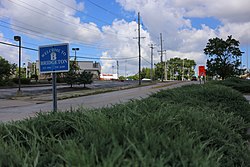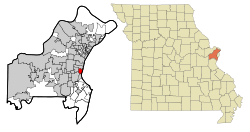Bridgeton is a second-ring suburb of Greater St. Louis in northwestern St. Louis County, Missouri, United States. Bridgeton is located at the intersection of the St. Louis outer belt and I-70. Bridgeton serves as the primary transport hub within Greater St. Louis. The population at the 2010 census was 11,550.[6] Portions of Lambert-St. Louis International Airport are within Bridgeton.[7]
The populated areas of the city are located between Lambert-St. Louis International Airport and St. Charles. The Missouri River serves as the city’s northwestern boundary. Bridgeton is centered at 38°45’26” North, 90°25’4″ West (38.7573, -90.4179).[8]
The area has long been influenced by its proximity to important local transportation routes, dating back to Native American trails established by the Osage Nation. Many of those trails became the basis of the first roads in the area, such as Natural Bridge and the historic St. Charles Rock Road, which date back to the days of Spanish, French, and early American settlement. The intersection of I-70 and I-270 in this area add to air and rail access to make the area a good base for transportation-dependent industries. The recreational American Discovery Trail passes through the area. [9]
According to the United States Census Bureau, the city has a total area of 15.24 square miles (39.47 km2), of which 14.60 square miles (37.81 km2) is land and 0.64 square miles (1.66 km2) is water.[10]
Early history
Bridgeton has a long and uneven history. The first Europeans to interact with Native American peoples and settle there were associated with the area’s days as part of the French Illinois Territory. The French explorer, Étienne de Veniard de Bourgmont traveled the area in 1724, on a trail that developed as the main route between St. Louis and St. Charles.
The Spanish gained colonial control in 1768 after France was defeated by Great Britain in the Seven Years’ War and ceded its territory west of the Mississippi to Spain; they remained in control until 1804, when the area was transferred to the Americans in the Louisiana Purchase. In a 1799 census, the population of “Marais des Liards” was given as 337 whites and 42 slaves.[11]
Bridgeton was first platted in 1794, and named Marais des Liards (Cottonwood Swamp). It was also known as Village à Robert, named after Robert Owen, its founder, who had received a land grant from the Spanish government. In a Spanish census two years later it had a population (including slaves) of 77 males and 47 females.[citation needed] As the area received more and more English-speaking settlers, the village’s name became Owen’s Station.
Because of its location, including its proximity to a ferry across the Missouri River, Bridgeton became a stop along the way from St. Louis to St. Charles. Meriwether Lewis passed through on his way to meet members who were gathering as part of the Lewis and Clark Expedition. The city was granted a state charter in 1843; throughout the next few years it was a stop along the way for emigrants seeking the major trailheads to the Oregon and Santa Fe trails.
The Jesuits, a Catholic religious order of priests and brothers, came to Bridgeton from St. Stanislaus Seminary and St. Ferdinand Parish of Florissant, Missouri. The order established St. Mary’s Church in 1851 as a mission to serve area Catholics; it became a full parish within its first year. The Archdiocese of St. Louis suppressed the parish in 2001 due to the expansion of Lambert-St. Louis International Airport, which caused a decline in residential population.
Modern history
By 1950, Bridgeton’s population was 276, lower than it had been in the late 1790s and early 19th century. The city expanded in size during the decade, growing through annexation, to 16 square miles (41 km2). The decade included the founding of the Northwest Chamber of Commerce,[12] the chamber of commerce for the Northwest St. Louis area, which includes Bridgeton.[13]
This led into its period of greatest residential growth, the 1960s, during which nearly 8000 single-family homes were built. Denser development was strong during that decade as well, at nearly 2000 units. Unlike with single-family development, the multi-family development continued at about the same average pace during the 1970s and 1980s.
While residential construction nearly ended in the 1990s, that decade has seen significant growth in commercial development. Levee-protected floodplains of the river, together with good access to interstate highways, rail, and the airport have translated into continued growth for Bridgeton and nearby communities, and a diversification of the city’s tax base. Proximity to Lambert-Saint Louis International Airport proved to be a mixed blessing. Starting in 1995, an expansion plan for the airport,[14] centered on a new runway plan called W-1W, was fought (unsuccessfully) by the city. The new runway led to the elimination of 2000 homes in the city, most notably in the Carrollton subdivision, undoubtedly playing a significant role in the city’s recent population decline.[15]
Regional airline Trans States Airlines is headquartered in Bridgeton.[7][17] Trans States subsidiary GoJet Airlines is also headquartered in Bridgeton.[18]
The only Level II Trauma Center in North St. Louis County, SSM DePaul Health Center, is located in Bridgeton. It is a 476-bed, full-service, Catholic hospital and a member of SSM Health Care-St. Louis, sponsored by the Franciscan Sisters of Mary. Opened in 1828, SSM DePaul was the first hospital west of the Mississippi River and remains one of the oldest continuously existing businesses in St. Louis.
Bridgeton, Missouri
City


Coordinates
Country
United States
State
County
Government
• Mayor
Area
[1]
Total
Land
Water
Elevation
Population
(2010)[2]
505 ft (154 m)
Total
Estimate
(2018)[3]
Density
Time zone
Summer (DST)
FIPS code
GNIS feature ID
Website
Woemmel is a St. Louis based Plastering company with a concentration in Residential, Commercial, Ornamental, and Plater Repair.

